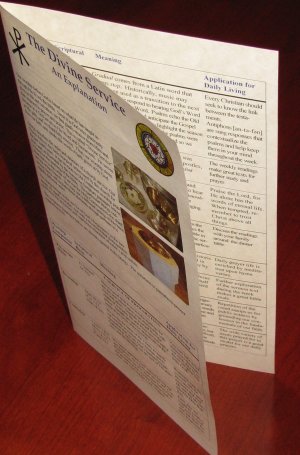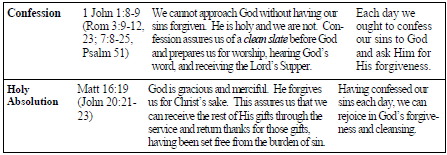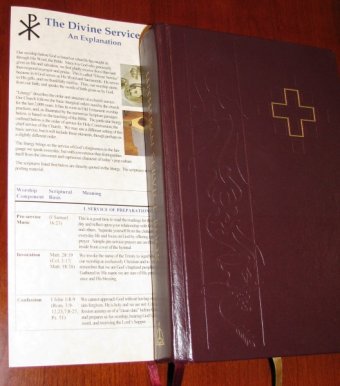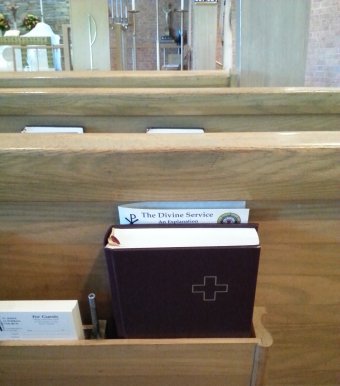
The Divine Service -- an Explanation
Life-long Lutherans come to church each Sunday, open the hymnal to the right page, and are ready to worship. But a visitor coming in for the first time may find the order of service confusing and intimidating. Without an understanding of what the Divine Service means, they may leave and never come to experience the richness and deep significance of Lutheran worship. Some life-long Lutherans may have learned about the parts of the service as a teenager and are now saying them from memory without understanding what each part means.
This is where we can help. we have prepared a beautiful full-color four-page pew card which explains what Lutherans do in worship and why. It's designed to fit in the church's pew racks, right behind the hymnals, but just a little taller so that the heading "The Divine Service - an Explanation" can be clearly read. It's printed on beautiful parchment-like paper, suggesting a sense of history, and it's laminated to make it attractive and durable. Each part of the service is explained in detail, along with scriptural references and applications for daily living. Ideal for reading prior to the start of the service or for studying later, "The Divine Service - an Explanation" will help visitors and members alike understand the incredible depth and beauty of the Divine Service. It's also useful as a teaching tool for confirmation or Bible classes to help members deepen their knowledge and appreciation for the worship they experience each week. This would have been very helpful when I first started attending my new church. As a visitor, and not being accustomed to a liturgical service, it took awhile before I was comfortable in actual worship. I couldn't figure out what the various parts meant or realize how biblical our worship service is!PD, Champaign IL
Written by Lutherans who have a deep love for their worship tradition, but with a perspective that non-Lutherans will understand, "The Divine Service - an Explanation" will enhance your church's worship by bringing your congregation and visitors into a closer walk with the Savior, and a deeper understanding of what it means to worship Him.
Though intended for those congregations that use the Lutheran Service Book, other liturgical churches may find it valuable for their visitors or as a teaching tool.

Two parts of it are shown to the right. It breaks down the service into its various parts, then gives biblical references, the meaning, and an application for daily living for each part.
Order one or more 25-packs today.
Order using our online shopping cart.
Please email or call with questions or for other arrangements.
James R Cutler
[email protected]
(734) 673-5462
To review the document before ordering, you may Download and read or print it.
Here is a sample congregational newsletter article you can use to announce the addition of the pewcards at your church:
Understanding the Liturgy
Kyrie, Gloria in Excelsis, Sanctus, Agnus Dei, Nunc Dimittis – you see these words in our liturgy, but do you really understand what they mean and why they are there? What do the parts of the Divine Service mean? Can you explain these to a visitor coming in for the first time who may find the order of service confusing and intimidating? Our historic liturgy is solidly based on God’s word, enabling us to receive His gifts in Word and Sacrament. We need to understand how this is done.
We have a new pew card, "The Divine Service - an Explanation", which explains what Lutherans do in worship and why. Each part of the service is explained in detail, along with scriptural references. This will help visitors and members alike understand the incredible depth and beauty of the Divine Service. It's also useful as a teaching tool for confirmation or Bible classes to help members deepen their knowledge and appreciation for the worship they experience each week.
Use this card to enhance your own understanding and appreciation of the Divine Service. Share it with visitors and others.


We gratefully acknowledge the work of Pastor Timothy Rossow who developed the first version of this publication.